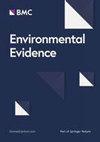评估基于自然的干预措施对减缓气候变化影响的证据:亚热带和热带陆域初级和二级研究的系统地图
IF 5.2
4区 环境科学与生态学
Q2 ENVIRONMENTAL SCIENCES
引用次数: 0
摘要
缓解气候变化的基于自然的干预措施包括一系列旨在保护、恢复和/或管理自然生态系统和改造生态系统的干预措施,以提高其储存和固碳能力,避免温室气体(GHG)排放。最近的预测估计,到2030年实现《巴黎气候协定》所需的气候变化缓解量的三分之一以上可由陆地nbi带来。此外,这些干预措施可以以社会和生态结果的形式提供共同效益。尽管越来越多的人认识到潜在的好处,但对支持不同类型的nbi与减缓气候变化成果、生态系统和人类之间的联系的证据的分布和发生的明确特征仍然知之甚少。该系统地图评估了热带和亚热带陆域nbi与气候变化减缓、社会和生态结果之间联系的证据基础。我们检索了3个书目数据库,65个组织网站,并在39个现有证据合成中进行了反向引文追踪,以确定相关文章。此外,我们还联系了关键的线人,以获取更多的证据来源。然后,我们使用机器学习在标题和摘要阶段根据相关性对返回的结果进行排名,并在标题、摘要和全文阶段使用预定义的标准手动筛选是否包含。我们使用先验编码方案从纳入的文章中提取相关元数据。最后,我们进行了一项有针对性的互补搜索,以确定相关的综述和综合文章,为系统图谱的发现提供更广泛的背景。我们将948篇文章纳入这一系统图谱。大多数证据基础(56%)审查了保护、自然资源管理和恢复干预措施与减缓气候变化的“代理”结果(土地状况、土地覆盖和/或土地利用的变化)变化之间的联系。文章发生率高的其他领域包括自然资源管理中的干预措施与农田类别中的树木之间的联系以及地上碳储存和/或固存的变化(占文章的17%)。一个关键的知识缺口是所有干预类型中温室气体排放的测量变化(占文章的6%)。总体而言,证据库中的文章通常没有评估共同效益的变化以及减缓气候变化的直接或间接变化(32%)。在大多数情况下,证据基础包含的研究没有使用适当的实验或准实验设计明确检验因果关系。结论nbi的证据基础丰富且不断增长;然而,知识方面的重大差距阻碍了为正在进行和未来的大规模投资和实施提供信息的能力。需要更全面的证据来支持nbi与缓解气候变化的直接结果之间的因果推理,以便更好地确定附加性、持久性、泄漏性和其他意外后果。同样,从这张地图中得出的优先事项包括,需要协调一致地努力收集各种数据类型,以便更好地了解是否以及如何协同实现国家基础设施的其他成果(例如社会、生态),以实现缓解目标。了解nbi的潜在利益和权衡对于为迅速扩大的自然碳市场提供信息尤为迫切。本文章由计算机程序翻译,如有差异,请以英文原文为准。
Assessing evidence on the impacts of nature-based interventions for climate change mitigation: a systematic map of primary and secondary research from subtropical and tropical terrestrial regions
Abstract Background Nature-based interventions (NbIs) for climate change mitigation include a diverse set of interventions aimed at conserving, restoring, and/or managing natural and modified ecosystems to improve their ability to store and sequester carbon and avoid greenhouse gas (GHG) emissions. Recent projections estimate that terrestrial NbIs can lead to more than one-third of the climate change mitigation necessary to meet the Paris Climate Agreement by 2030. Further, these interventions can provide co-benefits in the form of social and ecological outcomes. Despite growing recognition of the potential benefits, a clear characterization of the distribution and occurrence of evidence which supports linkages between different types of NbIs and outcomes for climate change mitigation, ecosystems, and people remains poorly understood. Methods This systematic map assesses the evidence base on the links between NbIs and climate change mitigation, social, and ecological outcomes in tropical and subtropical terrestrial regions. We searched three bibliographic databases, 65 organization websites, and conducted backward citation chasing within 39 existing evidence syntheses to identify relevant articles. Additionally, we reached out to key informants for additional sources of evidence. We then used machine learning to rank returned results by relevance at the title and abstract stage and manually screened for inclusion using predefined criteria at the title, abstract, and full text stages. We extracted relevant meta-data from included articles using an a priori coding scheme. Lastly, we conducted a targeted, complementary search to identify relevant review and synthesis articles to provide broader context for the findings of the systematic map. Review findings We included 948 articles in this systematic map. Most of the evidence base (56%) examined links between protection, natural resource management, and restoration interventions with changes to ‘proxy’ outcomes for climate change mitigation (changes to land condition, land cover, and/or land use). Other areas with high occurrence of articles included linkages between interventions within natural resource management and trees in croplands categories and changes to aboveground carbon storage and/or sequestration (17% of articles). A key knowledge gap was on measured changes in GHG emissions across all intervention types (6% of articles). Overall, articles in the evidence base did not often assess changes in co-benefits alongside direct or indirect changes for climate change mitigation (32%). In most cases, the evidence base contained studies which did not explicitly test for causal linkages using appropriate experimental or quasi-experimental designs. Conclusions The evidence base for NbIs is significant and growing; however, key gaps in knowledge hamper the ability to inform ongoing and future investment and implementation at scale. More comprehensive evidence is needed to support causal inference between NbIs and direct outcomes for climate change mitigation to better determine additionality, permanence, leakage, and other unintended consequences. Similarly, priorities emerging from this map include the need for coordinated and harmonized efforts to collect diverse data types to better understand whether and how other outcomes (e.g. social, ecological) of NbIs can be achieved synergistically with mitigation objectives. Understanding potential benefits and trade-offs of NbIs is particularly urgent to inform rapidly expanding carbon markets for nature.
求助全文
通过发布文献求助,成功后即可免费获取论文全文。
去求助
来源期刊

Environmental Evidence
Environmental Science-Management, Monitoring, Policy and Law
CiteScore
6.10
自引率
18.20%
发文量
36
审稿时长
17 weeks
期刊介绍:
Environmental Evidence is the journal of the Collaboration for Environmental Evidence (CEE). The Journal facilitates rapid publication of evidence syntheses, in the form of Systematic Reviews and Maps conducted to CEE Guidelines and Standards. We focus on the effectiveness of environmental management interventions and the impact of human activities on the environment. Our scope covers all forms of environmental management and human impacts and therefore spans the natural and social sciences. Subjects include water security, agriculture, food security, forestry, fisheries, natural resource management, biodiversity conservation, climate change, ecosystem services, pollution, invasive species, environment and human wellbeing, sustainable energy use, soil management, environmental legislation, environmental education.
 求助内容:
求助内容: 应助结果提醒方式:
应助结果提醒方式:


